
Taxus floridana, the Florida yew, is a species of yew, endemic to a small area of the Apalachicola River. This species is has restricted extent of occurrence (EOO) of 24km along the Apalachicola River and resides in the mesophytic forests of northern Florida at altitudes of 15–40 m. It is listed as critically endangered and is protected in reserves at the Torreya State Park and at the Nature Conservancy's Apalachicola Bluffs and Ravines Preserve. The Florida yew has legal protection under the United States and Florida Endangered Species laws. This species is considered endangered because of how rare it is and its limited range. This article writes about the description and ecology of the Florida yew, as well as discusses the ongoing threats and conservation attempts.
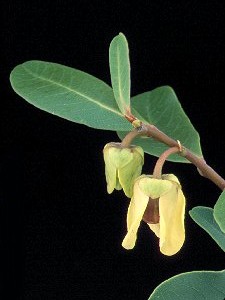
Asimina tetramera, commonly known as the four-petal pawpaw, is a rare species of small tree or perennial shrub endemic to Martin and Palm Beach Counties in the state of Florida. The species is currently listed as endangered under the Endangered Species Act and as endangered by the International Union for Conservation. The four-petal pawpaw is part of the family Annonaceae alongside other Asimina species.

Calopogon multiflorus, the many-flowered grass-pink, is a species of orchid. It is a perennial forb that requires recurring ground fires to maintain its habitat. It falls under the genus Calopogon, meaning "beautiful beard" in Greek, referring to the stamen-like bristles or beard on the lip.

Warea carteri is a species of plant in the mustard family, Brassicaceae, known by the common names Carter's pinelandcress and Carter's mustard. It is an endangered, fire-dependent annual herb occurring in xeric, shrub-dominated habitats on the Lake Wales Ridge of central Florida in the United States.

Chionanthus pygmaeus is a rare species of flowering plant in the olive family known by the common name pygmy fringetree. It is endemic to Florida, where there are 46 known occurrences as of 2010. The plant is found in increasingly rare habitat in Central Florida that is being consumed for development, and some protected areas are not managed adequately. Most populations are small. It is a federally listed endangered species of the United States.

Chrysopsis floridana is a rare species of flowering plant in the family Asteraceae, known by its common name, Florida golden aster. It is endemic to Florida in the United States, where it is known from Hillsborough, Hardee, Manatee, and Pinellas Counties. It is considered an endemic of the west-central coast of the state in the general vicinity of Tampa Bay. There are 17 to 20 occurrences, many of which have few individuals, but one of which has over one million plants. In 1986 the plant was added to the US endangered species list because it was becoming increasingly rare, it was growing only on private property, and its habitat was unprotected and being destroyed and degraded by a number of forces. It is found at Bell Creek Nature Preserve in Riverview, Florida.

Conradina etonia is a rare species of shrub in the mint family known by the common name Etonia rosemary. It is endemic to Putnam County, Florida, where it is known from about 8 populations on Etoniah Creek State Forest containing fewer than 1000 total individuals. It has a specific habitat requirement and the main threat it faces is destruction and degradation of its habitat. It is a federally listed endangered species of the United States.

Conradina glabra is a rare species of shrub known by the common names Apalachicola rosemary or Apalachicola false rosemary. It is endemic to Liberty County, Florida, where it is known from about ten populations. It is found only in a small area and it is threatened by habitat destruction. It is a federally listed endangered species.
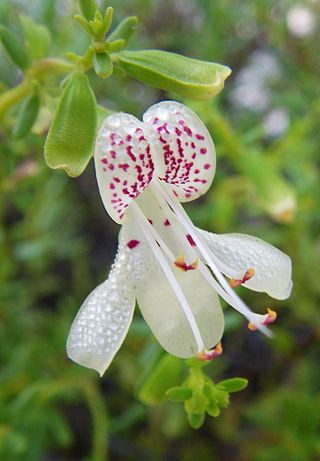
Dicerandra christmanii is a rare species of flowering plant in the mint family known by the common names Garrett's mint, yellow scrub balm, and Lake Wales balm. It is endemic to Highlands County, Florida, in the United States, where it is known from only four sites on the Lake Wales Ridge. All are contained within a tract of land measuring 6 kilometers by 3 kilometers. The plant is steadily declining due to the destruction and degradation of its habitat, and only one of the four occurrences is on protected land. It is a federally listed endangered species.

Dicerandra frutescens is a rare species of flowering plant in the mint family known by the common names scrub mint and scrub balm. It is endemic to Highlands County, Florida, where it is known only from the Lake Wales Ridge. Its habitat is quickly being lost as it is converted to residential and agricultural use. It was federally listed as an endangered species of the United States in 1985.

Euphorbia telephioides is a rare species of euphorb known by the common name Telephus spurge. It is endemic to Florida in the United States, where it is known only from three counties in the Panhandle. It is a federally listed threatened species of the United States.
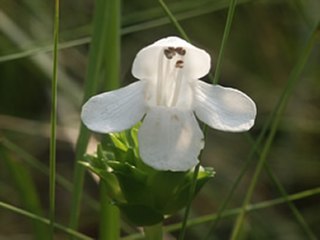
Macbridea alba is a rare species of flowering plant in the mint family known by the common name white birds-in-a-nest. It is endemic to Florida in the United States, where it is found in four counties in the Florida Panhandle. It is threatened by the loss and degradation of its habitat, and it is federally listed as a threatened species of the United States.
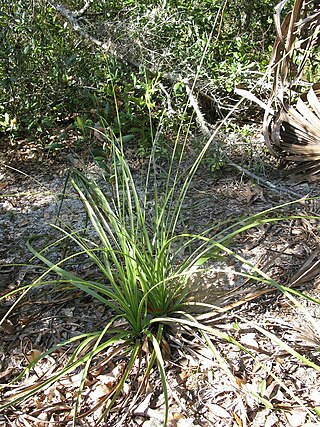
Nolina brittoniana is a rare species of flowering plant in the asparagus family known by the common name Britton's beargrass. It is endemic to Florida, where there are 72 known populations, only a few large enough to be considered viable. It is federally listed as an endangered species of the United States.

Pinguicula ionantha is a rare species of flowering plant in the butterwort family known by the common names Godfrey's butterwort and violet butterwort. It is endemic to the US state of Florida, where it only occurs in the central Florida Panhandle. It is threatened by the loss of its habitat, and it is a federally listed threatened species of the United States.
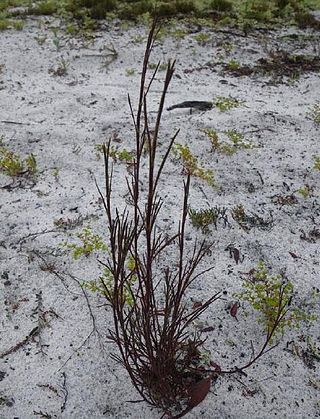
Polygonum basiramia is a rare species of flowering plant in the knotweed family known by the common names wireweed, hairy wireweed, purple wireweed, and Florida jointweed. It is endemic to Florida in the United States, where it is limited to the central ridges of the peninsula, including the Lake Wales Ridge. It is threatened by the loss and degradation of its habitat. It is a federally listed endangered species of the United States.
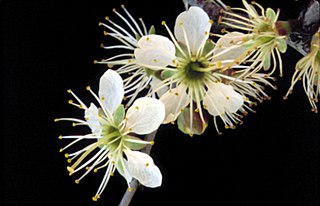
Prunus geniculata is a rare species of plum known by the common name scrub plum. The species is endemic to Florida.

Sidalcea nelsoniana is a rare species of flowering plant in the mallow family known by the common names Nelson's checkerbloom and Nelson's checkermallow. It is native to the Willamette Valley and Coast Range of Oregon and the southwestern corner of Washington in the United States. It is threatened by the destruction and degradation of its habitat, and it is a federally listed threatened species of the United States.

Spigelia gentianoides is a rare species of flowering plant in the Loganiaceae known by the common names purpleflower pinkroot and gentian pinkroot. It is native to Alabama and Florida in the United States, where a few small populations remain. It is threatened by the loss and degradation of its habitat, and is a federally listed endangered species of the United States.

Thalictrum cooleyi is a rare species of flowering plant in the buttercup family known by the common name Cooley's meadow-rue. It is native to the southeastern United States, where it is present in North Carolina, Georgia, and Florida. It is threatened by habitat destruction and degradation. It is a federally listed endangered species of the United States.

Nemastylis floridana is a species of flowering plant in the family Iridaceae known by the common names Florida celestial, fallflowering pleatleaf, and fallflowering ixia. It is endemic to Florida in the United States, where it faces many threats to its existence, but so far remains viable.





















